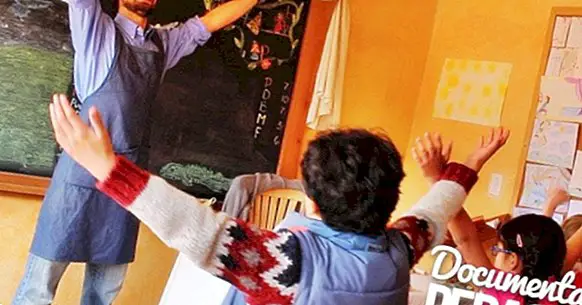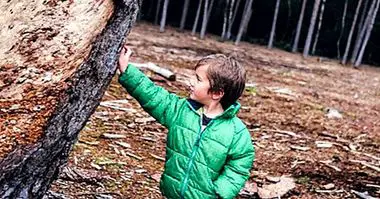Waldorf Pedagogy: its educational keys and philosophical foundations
In the month of April 1919, a philosopher of Austrian origin called Rudolf Steine r He gave a lecture at the Waldorf-Astoria tobacco factory in Stuttgart, Germany. Before an audience formed mainly by members of the working class of the tobacco company, Steiner He spoke about the need to erect an educational model not based on the assumption that human beings must learn to adapt to the demands of governments and large companies .
Schools, Steiner said, should serve to make all human potential develop naturally, not to equip young people with the tools with which they will later be forced to continue to operate the gears of the State and industry.
A few months later, at the request of the general director of the factory, the philosopher created the new educational center for the workers of the Waldorf-Astoria factory . The first of the so-called Waldorf schools had seen the light. Today there are more than 1,000 around the world.
Understanding the origins of Waldorf schools
The ideals of which the Austrian spoke at his tobacco conference were part of the germ of a new way of understanding teaching and the possibilities of personal development of what would later be known as Waldorf pedagogy , an educational system proposed by Steiner himself and which continues to be applied today in many private schools.
Why has it become so popular since the creation of the first Waldorf school? Probably play in his favor the rejection of formal education who saw a new impulse from the movement New Age of the 70s and that has given oxygen to several "alternative" education initiatives in which ruled as much as possible the regulated education and the imposition of rigid patterns of behavior.
Although the Waldorf pedagogy had its beginnings in a stage of economic and political instability in which the risk of poverty threatened important layers of population, the current welfare states have found a space for these alternative schools as a proof of the freedom with the one that certain people can choose (if they can pay for it) for the type of education that best suits their philosophy.
What are the characteristics of the Waldorf pedagogy?
It is clear that if there are schools of the tradition initiated by Steiner, it is because there are people who recognize their qualities and know how to distinguish them from others , since it's basically about Private schools . Now, what are these characteristics?
It is difficult to summarize in a few points the differentiating aspects that characterize the Waldorf pedagogy, and more taking into account that not all the schools that adhere to it do it in the same way, but the following points can be highlighted:
1. Embraces an "integral" or holistic educational approach
The Waldorf pedagogy emphasizes the need to educate not only the intellect, but also human qualities whose reach goes beyond rationality , like the management of moods or creativity. In practice, this means that Waldorf schools work on aspects and skills whose potential is, according to Steiner's followers, under-worked in most schools.
2. The idea of "human potential" has spiritual overtones
Education is not conceived as a transmission of knowledge or a teaching and learning process whose fruits can be evaluated with standardized tools of evaluation and fulfillment of objectives. It is, in any case, a dynamic between the student and the educating community that should allow him or her to develop both in measurable skills objectively and in a spiritual plane .
3. Flexibility and creativity in learning are enhanced
The content school curriculum with which you work in Waldorf schools orbits largely around arts and crafts . In this way, students learn through artistic representation of the contents of what they are taught, either by creating stories related to what they have learned, by inventing simple choreography, drawing, etc.
4. Emphasizes the need to form educational communities
From the Waldorf pedagogy strategies are sought to enhance the involvement of parents in the education of their children both at home and in extracurricular activities . At the same time, a large part of the activities carried out in the classes of the Waldorf schools have to do with everyday activities typical of domestic life. In short, the emergence of a networked education in which both family members and professionals of the pedagogy participate, so as not to reduce the teaching space to the school.
5.The focus is on the unique character of each student
From the Waldorf pedagogy, special emphasis is placed on the the need to offer a personalized treatment to the students, and this is reflected in a certain flexibility when evaluating the progress of each trainee . In this way, in many cases only standardized tests are used when it is essential and when the legality of each country so requires.
6. Education is adapted to the three phases of development in young people
Steiner theorized that during the first years of life, all human beings experience three stages of growth, each with a type of associated learning . According to this thinker we learn by imitation until reaching the age of 7 years, through rhythm, images and imagination between seven and fourteen years, and from abstract thinking in later years. In short, these three stages are ordered from a phase in which students can only learn from those images with which they are directly confronted to one in which they can freely draw conjectures about the reality that surrounds them.
From the idea of development in three phases, Waldorf teachers are concerned with adapting the quality of learning to the stage of growth through which each student theoretically passes. , and believe that exposing a person to a type of education for which they are not prepared can be harmful to them. That is why, among other things, Waldorf schools are known for not teaching their students to read until they reach the age of 6 or 7 years (somewhat later than usual in other schools) , nor do they use technologies such as computers or videogames until the students have reached adolescence, based on the belief that these devices could limit their imaginative capacity.
Progressive schools?
The Waldorf pedagogy seems advanced to its time in many ways. For example, the idea that education goes far beyond the classroom of the school is something that has only recently been assumed in the predominant educational systems in some Western countries. In the same way, it does not do so much that the notion of learning that is not based on the accumulation of practices and memorized lessons has become widespread among schools , but in the use of the tools provided by the teacher to learn certain things when the stage of development meets those objectives, neither before nor after.
In addition, the need to educate young people in aspects that go beyond the use of the intellect becomes increasingly important, something that resembles the ideal of education of Steiner, in which all the potentialities of the human being are developed to the time, in all human dimensions and in as many contexts as possible (at school, at home, in volunteer activities ...). In this sense, Steiner's ideas seem to be closer to the objectives set by current educational models than the philosophical foundations of most schools of the early twentieth century. Only recently, and in parallel to what the Waldorf pedagogy has been proposing for decades, the hegemonic ideal of what should be education has tended to the holistic approach to teaching and the need for teachers, parents and guardians to educate and cooperate from their different fields of action .
However, this image of a progressive educational system does not cover all sides of the Waldorf pedagogy. This is so because, although Rudolf Steiner proposed a holistic approach to the education of young people, he did not propose any kind of holistic approach, nor one that served the good (in the abstract) of the students. The theoretical-practical principles of the educational system developed by Steiner are connected with a stream of spiritual thought that Steiner himself devised and that, of course, is unconventional nowadays.
It is an intellectual current that is often compared to the kind of religious philosophy typical of sects and that, moreover, is far from the secular view of the current educational models, which are increasingly based on the use of scientific method to investigate the effectiveness and ineffectiveness of certain methods. That is why, before considering the possibility of resorting to a Waldorf school, It is convenient to know something about the type of esoteric thinking in which they are based: the anthroposophy .
Anthroposophy: transcending the world of the physical
When Rudolf Steiner laid the foundations of the Waldorf pedagogy, he did so with an eye on a very clear objective: change society for the better . This is something he shares with other thinkers related to the world of education, such as Ivan Illich, and of course for a long time now important philosophers first glimpsed the social and political repercussions of pedagogy, its potentialities and the dangers that can lead to stop paying attention to the dilemmas that arise in it.
However, to fully understand the Waldorf pedagogy, its methods and objectives, it is not enough to take into account the pretensions that Steiner had when developing his ideas. It is necessary, also, Learn about the way in which this thinker conceived the reality and nature of the human being . Because Rudolf Steiner was, among other things, a mystic who believed in the need to access a spiritual world so that human potential could develop fully.
The whole original theory of Waldorf pedagogy has its reason for being in the anthroposophy . This means that in order to understand the educational system proposed by this thinker, it is necessary to assume that this connects with a philosophy that addresses theological and esoteric issues far removed from the ways of understanding life and nature in Western countries today. It is from this perspective of reality that Waldorf pedagogy makes sense, since their methods are not based on solid scientific evidence .
Among the postulates of anthroposophy is the assumption that there is a spiritual world that affects the physical world, that in some plane of reality there is reincarnation, that past lives affect the sense in which young people can develop and that Human beings have the potential to develop organs to access the spiritual world through a kind of self-realization. These ideas are not simple theory with which to fill textbooks, but they shape the type of education that is given in the Waldorf pedagogy and the goals of each of the actions of their teachers.
Of course, the content of the lessons is also affected by this esoteric cultural baggage . Some of the teachings associated with Waldorf schools are the myth of Atlantis, creationism, the existence of a spiritual world that only initiates can access and a "spiritual science" that can be understood by accessing this alternative reality. .
The conflict with science
As an esoteric-type current of thought, anthroposophy is itself a black hole for the scientific method, although from it very specific conclusions can be drawn about the functioning of the physical world. This makes it in conflict with the forms of pedagogy that want to mark the educational agenda based on empirical evidence to check which educational methods work and which do not.
For example, the fact of dividing the ontogenetic development of the human being in several stages of growth, with all the changes observable both in the physical or in the behavior, is something that evolutionary psychologists have been doing regularly. The stages of development proposals by Jean Piaget, for example, are a good example of this. However, Steiner's theory of child development is not based on a series of checks made following the scientific method, but is based, basically, on his beliefs about the separation between body and soul and concepts of a theological nature from the which started his explanations.
Thus, the methodology used by the traditional Waldorf pedagogy does not respond to criteria provided by exhaustive scientific research on the most effective ways of teaching and learning, but rather rests on a legacy of myths and impossible to prove theories . The Waldorf pedagogy does not have the endorsement of science as we understand it today. However, this does not mean that anthroposophy is not installed in several relevant entities.
A legacy that goes beyond theory
The margin for credulity is so wide within anthroposophy that it is not surprising that it has flourished in many theories and even artistic styles. In fact, the Waldorf pedagogy is not the only product of anthroposophy, but its main contribution in the field of education.
This current of thought makes inroads in all kinds of topics studied for centuries by philosophers and scientists, resulting in disciplines of marked character pseudoscientific like biodynamic agriculture or anthroposophic medicine . This explains why Steiner's intellectual legacy is still present in all types of entities and organizations, from research groups to, for example, Triodos Bank.
The role of these entities in the political and social sphere, although marginal, is still remarkable considering that they can act as pressure groups. The frictions between the guidelines to be followed in the schools that provide state and supranational bodies and the principles of anthroposophy, linked to the presupposition that there is a spiritual world that only some initiates can know, are not uncommon.
In fact, the fit between the model of the Waldorf pedagogy and the state regulations on education has also proved somewhat problematic, and the organisms linked to anthroposophy constantly struggle to ensure that the educational guidelines given by public administrations do not stifle the way of doing Waldorf schools and because the centers assigned to anthroposophy can qualify for public subsidies (something that has happened in some countries). An example of this is found in the Open EYE Campaign, an initiative in which Waldorf teachers participated and whose goal was to pressure the UK Department of Education to mold its guidelines on what the education of children up to 5 years, so that their methodologies were not excluded.
The uncertainty around Waldorf schools
Is it possible that the divorce between the scientific method and the Waldorf pedagogy does not make this educational system a bad alternative? It's hard to say, since not all the Waldorf schools work the same nor do they have to fully embrace the esotericism with which Steiner expressed himself . Similarly, it is difficult to know where the boundary between an orthodox Waldorf school and one that is simply influenced by the methods of Waldorf pedagogy or that copies its strategies, has nothing to do with anthroposophy. Many times the legal gaps and the lack of regulations in the denomination of the centers make uncertainty difficult for well-informed decision making about whether a Waldorf school in particular is a good alternative.
On the one hand, many parent associations complain about the legal loopholes in which some Waldorf schools move and therefore ask that specific regulations be established that allow them to be sure of the type of activities and methodologies used in schools. For the other, The efforts of many Waldorf schools to adjust to the demands of demand and public regulations mean that, in practice, they are little guided by the principles of Steiner and that, therefore, it is difficult to know what can be expected of them. .
Despite the limbo of information in which Waldorf education schools seem to float, it should be remembered that the fact that the Waldorf pedagogy rejects the scientific method means that the more these schools conform to Steiner's beliefs, the greater the risk that they may be implementing educational measures that put at risk the integrity of very young children. The lack of certainty about what happens in most Waldorf schools is appropriate for students is, in itself, something negative. Thus, The best way to judge how you work in a Waldorf school is to visit that particular school and judge on the spot .
Is Waldorf pedagogy harmful?
There is a relevant issue that goes beyond questioning the transparency, organization and functioning of Waldorf schools. Is about the effects that education based on this educational system can have on the mental health of students , especially those who come into contact with this type of school at a very young age. After all, teaching lessons about certain topics and spreading certain beliefs does not have to imply that the psychological integrity of the students is being compromised or that their learning is being delayed in certain areas, even though what is taught is not have the endorsement of science or of the contrasted study of history, but the teaching modality and the approach when learning certain skills could be inappropriate.
The truth is that the only conclusion that can be drawn about this is that it is necessary to conduct research in this sense, because the lack of information is absolute . There have been few independent studies that touch, albeit in passing, issues that have to do with the effects of Waldorf pedagogy on the psychology of students, and by themselves are insufficient to shed much light on the subject. Most of these investigations are about the age at which it is best to start teaching reading and writing to the youngest, and no great differences have been found between the boys and girls who are being taught at daycare and Those who receive their first lessons on the subject from 6 or 7 years. So, at the moment there seems to be nothing sure about the effectiveness or negative effects of this teaching style.
Some recommendations
Beyond scientific research focused specifically on aspects of Waldorf pedagogy, there are some recommendations that can be made from common sense. For example, young people diagnosed with autism they may find it difficult to adapt to an educational model that places so much emphasis on flexibility and the lack of structure of activities and games, for which the Waldorf pedagogy does not seem to be the right one for them.
In the same way, many of the advantages that the Waldorf pedagogy seems to offer are not exclusive, but rather belong to private education in general. The clearest is the option of having classes with few students in which the personalized treatment of the teaching staff towards the student is possible due to the economic situation of the educational center. Nowadays, what has opened the door to this possibility has not been the essentialist philosophy of a thinker, but the economic relief , where it exists.
Bibliographic references:
- Cunningham, A. Carroll, J. M. (2011). The Development of Early Literacy in Steiner- and Standard-Educated Children. British Journal of Educational Psychology, 81 (3), pp. 475 - 490.
- Ginsburg, I. H. (1982). Jean Piaget and Rudolf Steiner: Stages of child development and implications for pedagogy. Teachers College Record, 84 (2), pp. 327-337.
- Steiner, R. (2001). The Renewal of Education. Great Barrington, Massachusetts: Anthroposophic Press. Originally published in 1977.
- Steiner, R. (2003). A Modern Art of Education. Great Barrington, Massachusetts: Anthroposophic Press. Originally published in 1923.
- Steiner, R. (2003). Soul Economy: Body, Soul, and Spirit in Waldorf Education. Great Barrington, Massachusetts: Anthroposophic Press. Originally published in 1977.
- Suggate, S. P., Schaughency, E. A. and Reese, E. (2013). Children learning to read later catch up to children reading earlier. Early Chilhood Research Qarterly, 28 (1), pp. 33-48.
- Uhrmacher P. B. (1995). Uncommon Schooling: A Historical Look at Rudolf Steiner, Anthroposophy, and Waldorf Education. Curriculum Inquiry, 25 (4), pp. 381-406.



















